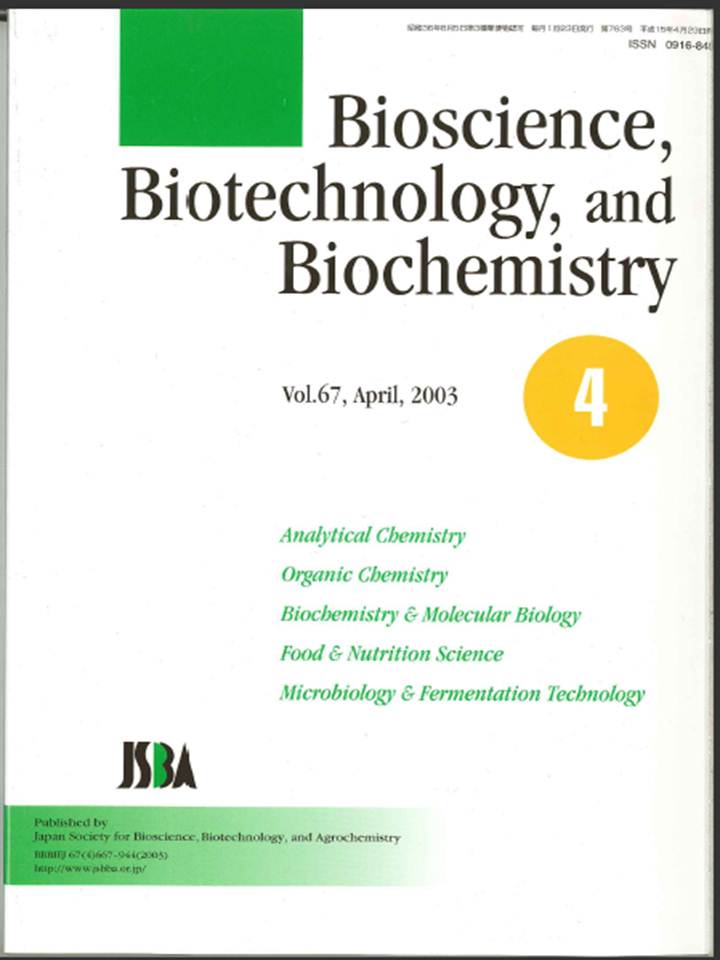Volume 67, Issue 4
Displaying 1-46 of 46 articles from this issue
- |<
- <
- 1
- >
- >|
Analytical Chemistry Regular Paper
-
2003Volume 67Issue 4 Pages 790-796
Published: 2003
Released on J-STAGE: June 28, 2003
Download PDF (258K)
Analytical Chemistry Note
-
2003Volume 67Issue 4 Pages 893-895
Published: 2003
Released on J-STAGE: June 28, 2003
Download PDF (205K)
Organic Chemistry Regular Papers
-
2003Volume 67Issue 4 Pages 822-829
Published: 2003
Released on J-STAGE: June 28, 2003
Download PDF (282K) -
2003Volume 67Issue 4 Pages 838-846
Published: 2003
Released on J-STAGE: June 28, 2003
Download PDF (326K)
Organic Chemistry Note
-
2003Volume 67Issue 4 Pages 911-913
Published: 2003
Released on J-STAGE: June 28, 2003
Download PDF (142K)
Biochemistry & Molecular Biology Regular Papers
-
2003Volume 67Issue 4 Pages 667-676
Published: 2003
Released on J-STAGE: June 28, 2003
Download PDF (1394K) -
2003Volume 67Issue 4 Pages 684-690
Published: 2003
Released on J-STAGE: June 28, 2003
Download PDF (205K) -
2003Volume 67Issue 4 Pages 698-703
Published: 2003
Released on J-STAGE: June 28, 2003
Download PDF (349K) -
2003Volume 67Issue 4 Pages 704-711
Published: 2003
Released on J-STAGE: June 28, 2003
Download PDF (330K) -
2003Volume 67Issue 4 Pages 720-728
Published: 2003
Released on J-STAGE: June 28, 2003
Download PDF (530K) -
2003Volume 67Issue 4 Pages 772-782
Published: 2003
Released on J-STAGE: June 28, 2003
Download PDF (643K) -
2003Volume 67Issue 4 Pages 815-821
Published: 2003
Released on J-STAGE: June 28, 2003
Download PDF (2766K) -
Family 19 Chitinase of Streptomyces griseus HUT6037 Increases Plant Resistance to the Fungal Disease2003Volume 67Issue 4 Pages 847-855
Published: 2003
Released on J-STAGE: June 28, 2003
Download PDF (1610K) -
2003Volume 67Issue 4 Pages 863-868
Published: 2003
Released on J-STAGE: June 28, 2003
Download PDF (840K) -
2003Volume 67Issue 4 Pages 869-876
Published: 2003
Released on J-STAGE: June 28, 2003
Download PDF (285K)
Biochemistry & Molecular Biology Notes
-
2003Volume 67Issue 4 Pages 881-883
Published: 2003
Released on J-STAGE: June 28, 2003
Download PDF (149K) -
2003Volume 67Issue 4 Pages 896-898
Published: 2003
Released on J-STAGE: June 28, 2003
Download PDF (208K) -
2003Volume 67Issue 4 Pages 899-902
Published: 2003
Released on J-STAGE: June 28, 2003
Download PDF (718K) -
2003Volume 67Issue 4 Pages 903-906
Published: 2003
Released on J-STAGE: June 28, 2003
Download PDF (138K) -
2003Volume 67Issue 4 Pages 914-918
Published: 2003
Released on J-STAGE: June 28, 2003
Download PDF (2261K) -
2003Volume 67Issue 4 Pages 919-922
Published: 2003
Released on J-STAGE: June 28, 2003
Download PDF (165K) -
2003Volume 67Issue 4 Pages 923-926
Published: 2003
Released on J-STAGE: June 28, 2003
Download PDF (829K) -
2003Volume 67Issue 4 Pages 927-929
Published: 2003
Released on J-STAGE: June 28, 2003
Download PDF (437K)
Biochemistry & Molecular Biology Preliminary Communication
-
2003Volume 67Issue 4 Pages 937-939
Published: 2003
Released on J-STAGE: June 28, 2003
Download PDF (128K)
Food & Nutrition Science Regular Papers
-
2003Volume 67Issue 4 Pages 677-683
Published: 2003
Released on J-STAGE: June 28, 2003
Download PDF (2148K) -
2003Volume 67Issue 4 Pages 691-697
Published: 2003
Released on J-STAGE: June 28, 2003
Download PDF (198K) -
2003Volume 67Issue 4 Pages 712-719
Published: 2003
Released on J-STAGE: June 28, 2003
Download PDF (308K) -
2003Volume 67Issue 4 Pages 729-735
Published: 2003
Released on J-STAGE: June 28, 2003
Download PDF (246K) -
2003Volume 67Issue 4 Pages 736-742
Published: 2003
Released on J-STAGE: June 28, 2003
Download PDF (232K) -
2003Volume 67Issue 4 Pages 743-751
Published: 2003
Released on J-STAGE: June 28, 2003
Download PDF (298K) -
2003Volume 67Issue 4 Pages 752-757
Published: 2003
Released on J-STAGE: June 28, 2003
Download PDF (199K) -
2003Volume 67Issue 4 Pages 758-764
Published: 2003
Released on J-STAGE: June 28, 2003
Download PDF (254K) -
2003Volume 67Issue 4 Pages 830-837
Published: 2003
Released on J-STAGE: June 28, 2003
Download PDF (313K) -
2003Volume 67Issue 4 Pages 856-862
Published: 2003
Released on J-STAGE: June 28, 2003
Download PDF (221K)
Food & Nutrition Science Notes
-
2003Volume 67Issue 4 Pages 877-880
Published: 2003
Released on J-STAGE: June 28, 2003
Download PDF (187K) -
2003Volume 67Issue 4 Pages 884-888
Published: 2003
Released on J-STAGE: June 28, 2003
Download PDF (741K) -
2003Volume 67Issue 4 Pages 907-910
Published: 2003
Released on J-STAGE: June 28, 2003
Download PDF (191K)
Food & Nutrition Science Preliminary Communication
-
2003Volume 67Issue 4 Pages 930-932
Published: 2003
Released on J-STAGE: June 28, 2003
Download PDF (144K)
Food & Nutrition Science Communication
-
2003Volume 67Issue 4 Pages 940-943
Published: 2003
Released on J-STAGE: June 28, 2003
Download PDF (190K)
Microbiology & Fermentation Technology Regular Papers
-
2003Volume 67Issue 4 Pages 765-771
Published: 2003
Released on J-STAGE: June 28, 2003
Download PDF (592K) -
2003Volume 67Issue 4 Pages 783-789
Published: 2003
Released on J-STAGE: June 28, 2003
Download PDF (402K) -
2003Volume 67Issue 4 Pages 797-802
Published: 2003
Released on J-STAGE: June 28, 2003
Download PDF (1812K) -
2003Volume 67Issue 4 Pages 803-808
Published: 2003
Released on J-STAGE: June 28, 2003
Download PDF (417K) -
2003Volume 67Issue 4 Pages 809-814
Published: 2003
Released on J-STAGE: June 28, 2003
Download PDF (260K)
Microbiology & Fermentation Technology Note
-
2003Volume 67Issue 4 Pages 889-892
Published: 2003
Released on J-STAGE: June 28, 2003
Download PDF (221K)
Microbiology & Fermentation Technology Preliminary Communication
-
2003Volume 67Issue 4 Pages 933-936
Published: 2003
Released on J-STAGE: June 28, 2003
Download PDF (169K)
- |<
- <
- 1
- >
- >|
